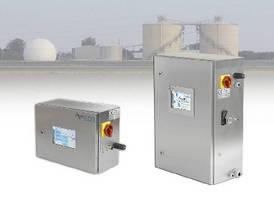Biogas Analyzer controls desulphurization.
Share:
Press Release Summary:

Designed to provide measurement for CH4, CO2, H2S, O2, and H2, with up to 5 measuring points, Awi-Flex Multi-Function Biogas Analyzer automatically controls micro-biological desulphurization, 24/7, without any human input. Small air compressor regulates air injection to digester to between 0.5-1% volume and breaks down H2s to less harmful elemental sulphur and water. Through PC interface, users can access recorded data, sensor parameters, and system diagnostics.
Original Press Release:
Intelligent Biogas Analysers Control Desulphurisation
With increasing volumes of waste now being processed to generate 'renewable energy' through the AD process (Anaerobic Digestion), it's important for plant operators to ensure that capacities are maintained and optimised. The primary purpose of an AD plant is to generate electricity from waste product such as animal slurry, food waste and crops. This electricity can then be sold to the National grid in return for cash, based on what are called "Feed-in-Tariffs" (FITS) which are determined by the government. For example, an AD plant that produces between 250 and 500Kw of electricity will receive 13.6p per Kwh.
When the waste material is stored in anaerobic conditions (no oxygen) the organic matter breaks down in the presence of bacteria and releases biogas which will typically contain from 50 to 70% methane. The balance is a mixture of carbon dioxide, water vapour and hydrogen sulphide (H2s), with the H2s in concentrations up to around 5,000ppm (parts per million). H2s is an unwanted bi-product of the process and smells of rotten eggs but more importantly, if concentrations occur at higher levels of around 1,000ppm, it can be fatal if inhaled.
Another issue with H2s is that although the biogas produced contains enough methane for it to be used as a fuel in combined heat and power units (CHP), when it's burned the presence of H2s in the gas combines with the water vapour to form a weak sulphuric acid and this would corrode the generator. The usual solution to the problem is for AD sites to install scrubbers which clean and scrub the gas to reduce the H2s content to acceptable levels. However, installing gas scrubbers for the desulphurisation process can be very expensive and it also involves continuous chemical dosing and constant maintenance. Also, the CHP plant represents the largest capital outlay of an AD project and the engine manufacturer's warranty is usually invalidated if the H2s concentration exceeds certain levels, typically 300 to 500 ppm.
An alternative to H2s scrubbers is microbial-desulphurisation which relies on injecting very small quantities of air into the biogas (providing it does not exceed 1 - 2%, the anaerobic process within the sludge will be unaffected). The oxygen breaks down the H2s into water vapour and elemental sulphur. This process is widely used as a low cost alternative to more expensive large scale scrubbers but requires constant attention from the plant operators. Too much air will kill the bacteria and stop the AD process, too little air and the H2s concentration will quickly rise.
Another option is to use biogas analysers and these are routinely used on AD sites to monitor and record the amount of methane and H2s within the biogas as it leaves the digester. Plant operators rely on the analyser to warn them of low levels of methane or particularly high levels of H2S caused by unstable anaerobic conditions which could result in a plant shutdown and ultimately, huge financial loses.
Now for the first time, there is a more sophisticated biogas analyser available from control and instrumentation specialists ALLISON ENGINEERING which is capable of automatically controlling micro-biological desulphurisation, without ANY human input, 24 / 7 and at significantly lower cost.
The Awi-Flex multi-function biogas analyser is supplied with a small air compressor which regulates air injection to the digester (above the sludge level) to between 0.5 to 1% volume and breaks down the H2s to less harmful elemental sulphur and water. By accurately measuring the O2 and H2s in the biogas and using a combination of PI and fuzzy logic control, H2s levels can be reduced by up to 80%.
Designed and manufactured in Germany, the Awi-Flex analyser is established as the market leader for biogas analysis on AD applications with thousands of units installed in Germany. It is designed to provide measurement for CH4, CO2, H2S, O2 and H2, with up to 5 measuring points. It features an integral rugged PC interface which enables easy access to recorded data, sensor parameters and system diagnostics, with 4-20 / Profibus / Ethernet communications.
Further details on the Awite range of Biogas Process Analysers which help to control and optimise biogas yields are available from:
Allison Engineering,
Allison House, Cranes Farm Road, Basildon, Essex, UK SS14 3JA
http://www.allison.co.uk/renewables/gas-desulphurisation.php
Email: sharwood@allison.co.uk Tel: 01268 526161 Fax: 01268 533144




